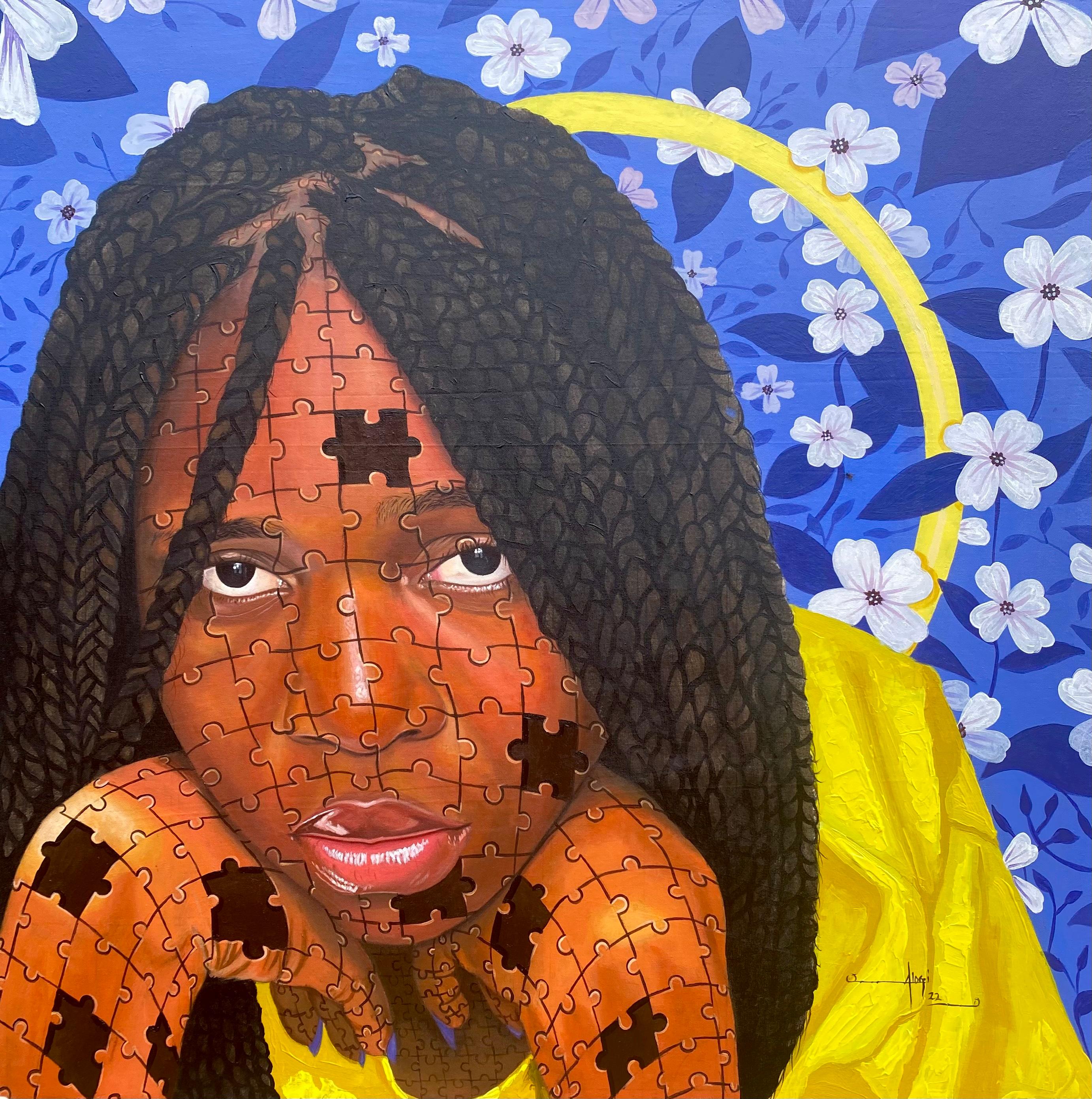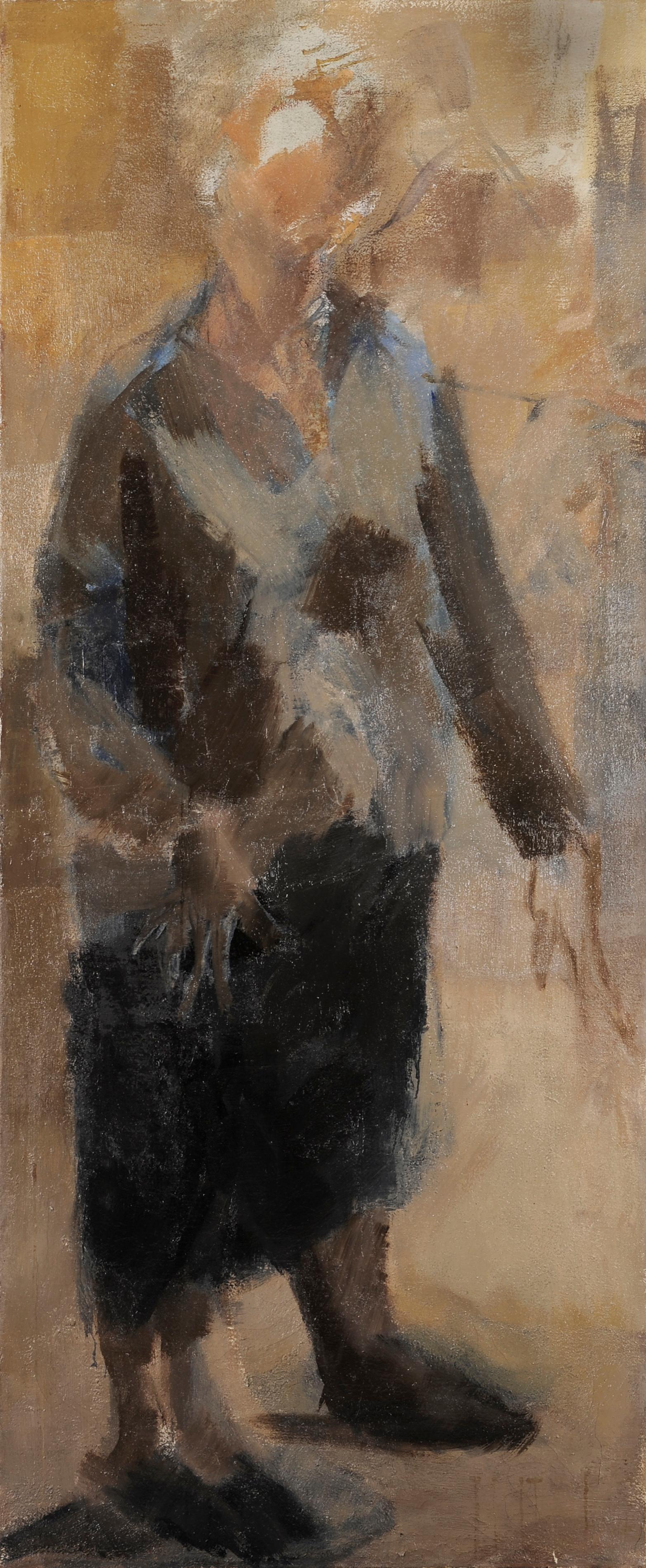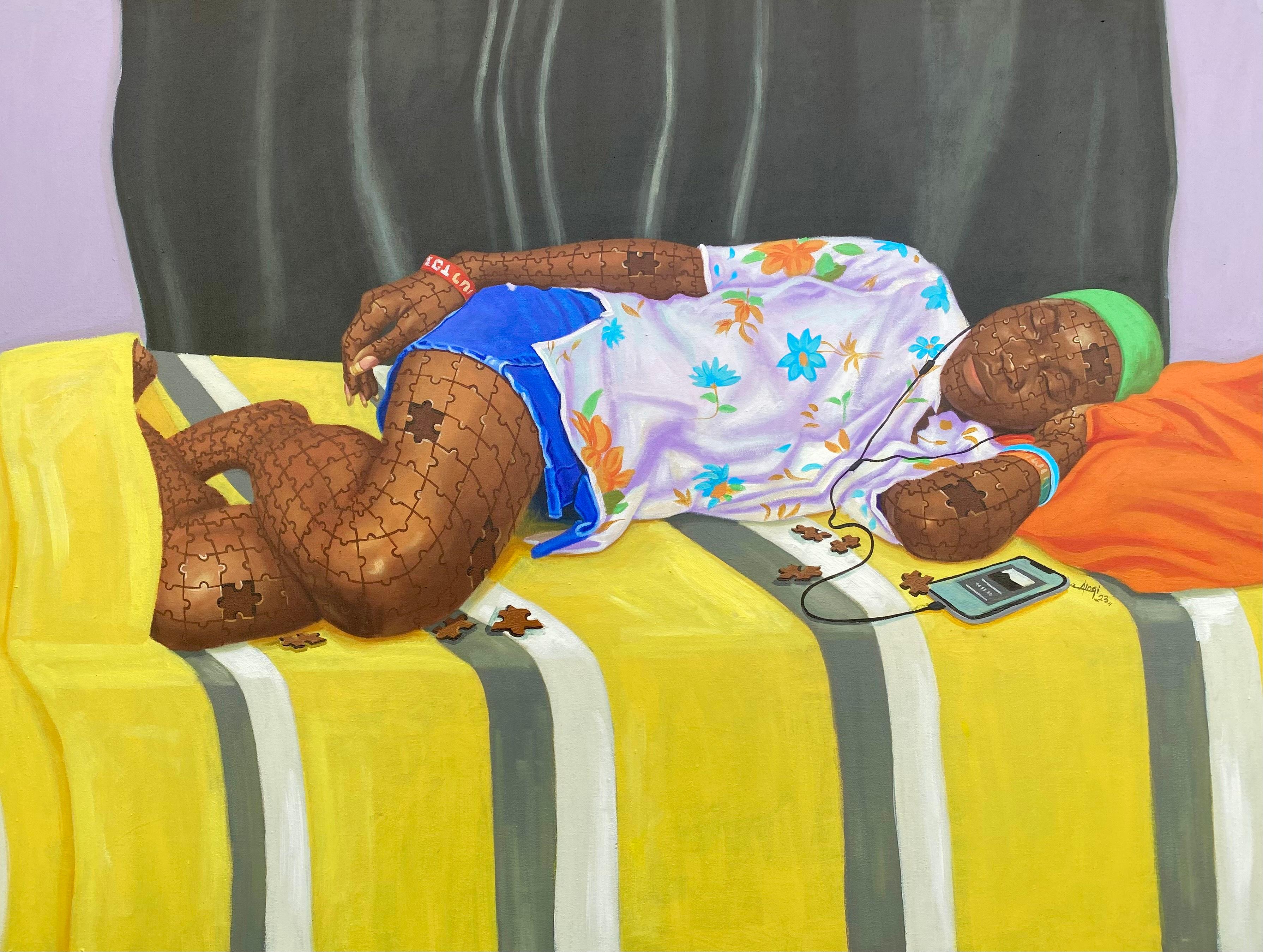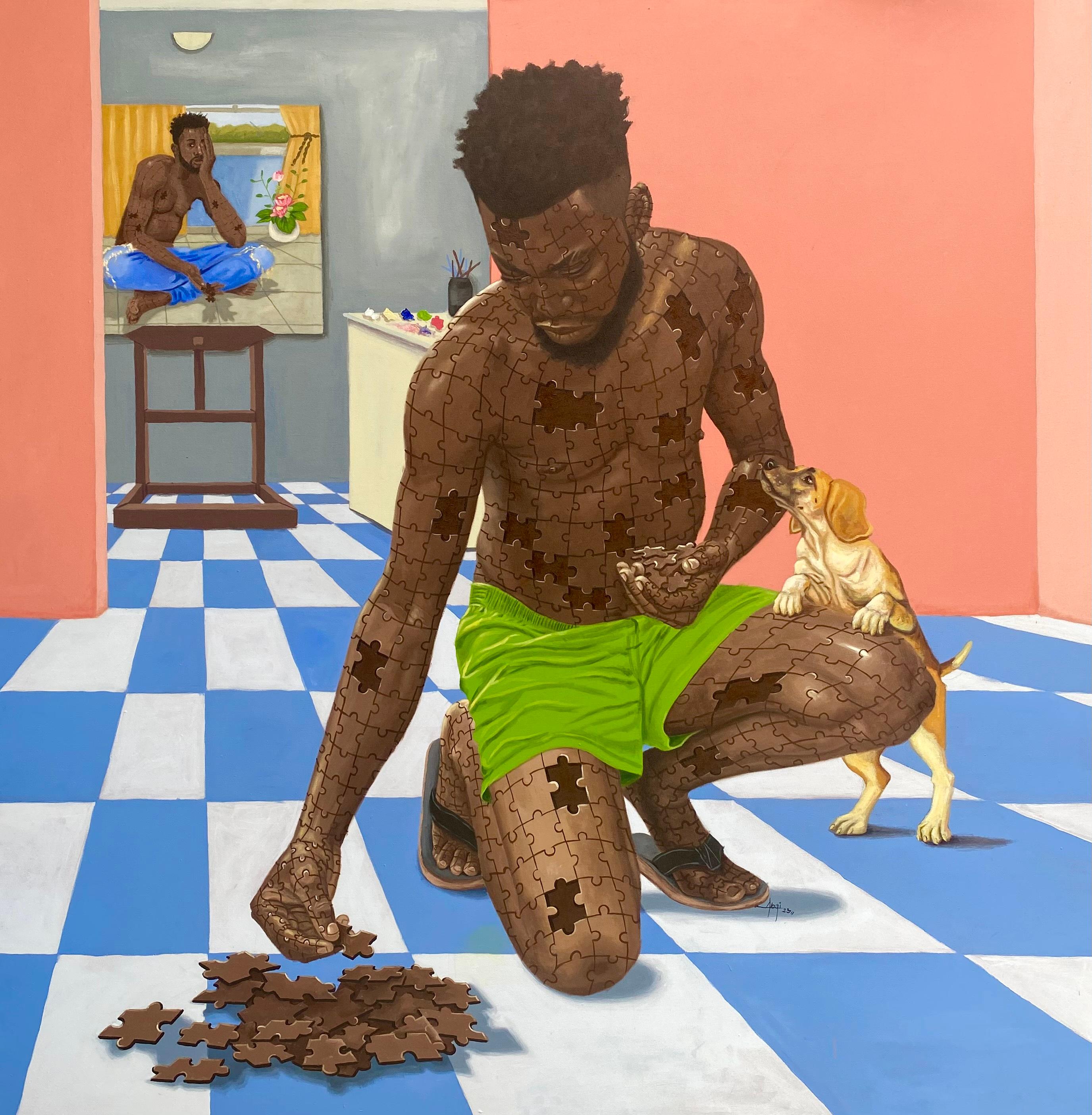Items Similar to Cubist Portrait of Gabriele Varese (in Italian uniform), 1919
Want more images or videos?
Request additional images or videos from the seller
1 of 10
Dick BeerCubist Portrait of Gabriele Varese (in Italian uniform), 19191919
1919
About the Item
Dick Beer (b. London 1893 - d. Stockholm 1938)
Portrait of Gabriele Varese (in Italian uniform), 1919
oil on canvas mounted on panel
116 x 90 cm
stamp signature
Exhibited:
Solo exhibition, Stockholm, Nov-Dec 1917;
The Royal Academy Stockholm 1973;
Åmells Konsthandel – En internationell kubist, Stockholm & London 2008
Hälsinglands Museum 2011
Millesgården – Dick Beer – Impressionist & Kubist, 2012
Provenance:
Within the family Beer until today
Dick Beer was born in 1893 in London as Richard Beer, the youngest of five brothers. His father, John Beer (1853-1906), was a watercolourist who was born in Stockholm and had left Sweden at the age of 17. John Beer instructed his sons in drawing and painting, among other things. A number of sketchbooks bear testimony to the boys’ talent.
Dick Beer’s parents died in 1906 and 1907. Barely 15 years old, Beer arrived in Sweden as an orphan. First he lived with relatives and finally he ended up at Reverend Laurell in Västergötland.
Dick Beer began his artistic studies at the Althin School of Painting in Stockholm in 1908 and continued at the Royal Academy of Arts in the autumn of 1910, but in September 1912 he broke off his studies and travelled to Paris. He rented a studio and enrolled at the Colarossi and Grande Chaumière academies.
In the summer of 1913, Dick Beer travelled to Pont-Aven in Bretagne in order to paint. In September the same year, he held his first solo exhibition in Stockholm which he gave the French title Exposition des tableaux de Bretagne et autour de Paris. The exhibition proved a success. Many of the paintings were executed in a light palette in a style inspired by the impressionists.
In 1914, Dick Beer undertook an extensive study trip to Italy, Tunis, Morocco and Spain, which resulted in canvases overflowing with colours and light. When the French army mobilised, he volunteered and was enlisted in the French Foreign Legion. In 1915 Dick Beer sustained severe head injuries in a grenade attack, which resulted in deafness and a nervous condition that would plague him for the rest of his life. Two of his brothers died the following year, fighting for the English army.
Dick Beer was hospitalised and convalesced at Château de Rochefort. Here he started painting again, in an impressionist style, a painting dominated by blue and green hues.
In 1918, Dick Beer married Ruth Öhrling, a dentist, and their son John was born later in the year. During this time, Beer began experimenting with cubist painting and created several large compositions, including the painting “The Arab Café”.
In the years that followed, Dick Beer was based in Paris, where he often moved house. He was instructed by André Lhote, who encouraged his students to work freely in the studio and provided them with individual critique. Beer often travelled to Bretagne or Provence. His artist friends came from all over Europe and included Amedeo Modigliani. Dick Beer exhibited fairly regularly in Paris between 1919 and 1934 and made a name for himself in French artist circles.
In the summers, Ruth regularly rented a house in the countryside, often at Lake Mälaren. She kept a large house with many models and friends and there was a lot of painting and discussions. In 1933, the couple divorced but Ruth still loved Dick and continued to support him financially for the rest of his life.
Dick Beer also exhibited in Sweden, albeit irregularly due to his failing health. In the 1920s and 1930s, Beer continued to pursue an expressionist painting with intense colours and unexpected perspectives, but eventually he veered towards more naturalistic forms, including a large number of nudes. He also painted several portraits of artists, politicians and writers.
In 1938, Dick Beer sojourned in Arles. The budding photographer Christer Strömholm became a student of Dick Beer’s and they developed an intimate friendship. In June the same year, Dick Beer died in Stockholm following complications of pneumonia.
Cubistic vision
In the period following the First World War, the artist’s painting underwent a fundamental transformation. Dick Beer was influenced by various modernistic expressions. In Paris, the first wave of cubism, led by Pablo Picasso and Georges Braque, was established. It was a controversial artistic style. There was a heated debate about cubism, in which the artist broke up the motif into smaller components, sometimes called facets, in order to rebuild it on the flat surface of the pictorial plane. This manner of painting represented a complete break with preceding pictorial conventions and naturalistic painting.
Cubism was governed by theory, not practice, and critics claimed that the style was too intellectual for the general public and they predicted that it would disappear and that artists would return to a rather more classic expression.
The theories surrounding cubism and its various expressions opened up for a number of reinterpretations in the 1910s. Dick Beer was well aware of the cubist discussions. He embraced the ideas but created a varied, personal and emotive cubism in the years around 1918. His painting was often an explosive discharge with playful characteristics and a futuristic dynamism which accentuated the painting’s inherent speed and movement, as for example his works “Dancer” and “The Toy Box”. He also experimented with geometric compositions of buildings and landscapes, which were reminiscent of Paul Cézanne’s more cubic landscapes. Here, Beer’s colours were often muted, in blue, brown and red hues. He frequently returned to earlier motifs and reworked his canvases into a cubist style, as in “Dancer tying her shoes” and “Seated dancer“.
Contemporary art critics were appalled and Beer had to endure severe criticism. At one point, the artist published a reply in the daily Politiken, 1919, where he described his view on art:
“... because love for and understanding of art, ‘l’art pour l’art’, is not easy to achieve, and neither is it easy to comprehend the different movements’ or schools’ origin, goals, characteristic endeavours, etc. – These international phenomena require not only theoretical and art historical knowledge but (...) the ability to empathise with and feel for art, as its practitioners do”.
- Creator:Dick Beer (1893 - 1938, Swedish, British)
- Creation Year:1919
- Dimensions:Height: 45.67 in (116 cm)Width: 35.44 in (90 cm)
- Medium:
- Movement & Style:
- Period:
- Condition:Very good condition, ready to hang.
- Gallery Location:Stockholm, SE
- Reference Number:1stDibs: LU1445211789442
About the Seller
5.0
Platinum Seller
These expertly vetted sellers are 1stDibs' most experienced sellers and are rated highest by our customers.
Established in 2020
1stDibs seller since 2020
118 sales on 1stDibs
Typical response time: <1 hour
Associations
International Confederation of Art and Antique Dealers' Associations
- ShippingRetrieving quote...Ships From: Stockholm, Sweden
- Return PolicyA return for this item may be initiated within 2 days of delivery.
More From This SellerView All
- An Italian Man With Hat and Scarf by Italian Artist Giuseppe GiardinelloLocated in Stockholm, SEFor sale is a beautiful small portrait by the Italian artist Giuseppe Giardinello, whose life spanned from 1887 to 1920. This work of art is a remarkable representation of Giardinell...Category
Early 20th Century Post-Impressionist Portrait Paintings
MaterialsWood Panel, Oil
- On the Sea (På havet, 1911) by Swedish Carl WilhelmsonLocated in Stockholm, SEThe painting På Havet (On the Sea) by Carl Wilhelmson, created in 1911, stands as a remarkable testament to the artist's profound connection with the s...Category
1910s Modern Figurative Paintings
MaterialsWood Panel, Oil
- The Pipe Smoker, Portrait by Italian Artist Giuseppe GiardinelloLocated in Stockholm, SEThis captivating small portrait is the work of Italian artist Giuseppe Giardinello, who lived from 1887 to 1920. Giardinello's talent for capturing the essence of his subjects is ful...Category
Early 20th Century Portrait Paintings
MaterialsWood Panel, Oil
- The Card Players by a Flemish 1600s ArtistBy Flemish School, 17th CenturyLocated in Stockholm, SEFlemish 1600s School The Card Players oil on oak panel panel dimensions 22.5 x 20 cm frame included Provenance: From a Swedish private collection. Condition: Flat and stabl...Category
17th Century Old Masters Figurative Paintings
MaterialsOak, Oil, Panel
- Portrait of a Young Boy With Hat, Possibly Painted by Gustaf BrandeliusLocated in Stockholm, SEUnknown Artist, Possibly Gustaf Brandelius (1833-1884) Portrait of a Young Boy With Hat oil on tree panel painted c.1850-70 panel 9.05 x 5.90 inches ...Category
1860s Portrait Paintings
MaterialsOil, Wood Panel
- French Girl with Flowered Hat with Impressive Sfumato Technic by Leon RichetBy Leon RichetLocated in Stockholm, SEIntroducing a stunning portrait by renowned French artist Léon Richet (1847-1907), depicting a young girl adorned with a beautiful floral wreath and a hat perched atop her head. This...Category
Late 19th Century Barbizon School Portrait Paintings
MaterialsOil, Panel
You May Also Like
- Elisabeth Dujarric de la Rivière (1930-2005) Self-portrait with paletteBy Élisabeth Dujarric de La RivièreLocated in BELEYMAS, FRElisabeth DUJARRIC de LA RIVIÈRE (Jouy-en-Josas 1930 - Excideuil 2005) Self-portrait with apple Oil on canvas H. 100 cm ; L. 73 cm Sig...Category
1950s Cubist Portrait Paintings
MaterialsOil, Canvas
- ExcursionLocated in Spetses, GRA human form wearing a hat in a classical vehicle's driver seat. Smooth lines and geometrical forms , by E. Malafouris. Oil on canvas ,ready to hang. Original prints & framing optio...Category
21st Century and Contemporary Cubist Portrait Paintings
MaterialsCanvas, Oil
- Portrait of the artist's motherBy Élisabeth Dujarric de La RivièreLocated in BELEYMAS, FRElisabeth DUJARRIC de LA RIVIÈRE (Jouy-en-Josas 1930 – Excideuil 2005) Portrait of the artist's mother Oil on canvas H. 171 cm; L. 70 cm Signed on the back Provenance: Private collection, Périgord Born in the heart of the Bièvre valley, a few kilometers from Versailles...Category
1950s Cubist Portrait Paintings
MaterialsCanvas, Oil
- Ray of HopeBy Alogi JohnLocated in Ibadan, Oyo"Ray of Hope" presents a compelling visual narrative that captures the viewer's attention with its elegant simplicity and emotive composition. The central focus is a lady, her eyes fixed on an unseen point, her hands gently supporting her face, and her flowing braided hair cascading down her shoulders. The artist skillfully employs light and shadow to accentuate the contours of her face, creating an ethereal glow that emanates from her serene expression. The painting's colors, a delicate blend of cool and warm tones, add a sense of depth and richness, further enhancing the artwork's emotional impact. The lady's introspective pose and piercing gaze offer a profound glimpse into the human experience. With her hands gently cradling her face, she exudes a sense of vulnerability and introspection, as if lost in her own thoughts and dreams. The flowing braided hair adds an element of timelessness and femininity, while also symbolizing the fluidity and interconnectedness of one's hopes and aspirations. "Ray of Hope" serves as a reminder that within the depths of contemplation, a spark of optimism and resilience can emerge, guiding individuals toward a brighter future. "Ray of Hope" finds its place within John Alogi's wider body of work, the "Dreams and Reality" series. This series explores the intersection between the subconscious and conscious mind, delving into the depths of human emotions, dreams, and aspirations. Each artwork within this collection invites viewers to question the boundaries between reality and imagination, offering glimpses into alternate worlds and unseen narratives. Alogi's unique ability to blend symbolism with evocative imagery gives birth to visual masterpieces that resonate with viewers on both intellectual and emotional levels. Alogi's artistic style is characterized by a delicate balance between realism and poetic abstraction. His meticulous attention to detail, particularly in capturing facial expressions and the intricacies of hair, results in a stunning portrayal of human emotion. The artist's use of light and shadow creates a sense of depth and luminosity that brings his subjects to life. Alogi's choice of colors, often muted and harmonious, adds to the dreamlike quality of his artwork, enveloping viewers in a world of contemplation and introspection. John Alogi's artwork, "Ray of Hope," captivates viewers with its mesmerizing portrayal of a lady lost in thought. As a part of his "Dreams and Reality" series, this masterpiece reflects the artist's profound understanding of the human condition, evoking a sense of introspection and emotional resonance. Through Alogi's skillful technique and symbolic imagery, the artwork transcends the boundaries of the canvas, inspiring contemplation and igniting a ray of hope within those who encounter it. "Ray of Hope" stands as a testament to the enduring power of art to touch the depths of our souls and remind us of the beauty and resilience within us all. Painting Ships in a well-protected tube from Nigeria This work is unique, this is not a print or other type of copy. Accompanied by a Certificate of Authenticity. About Artist Adeyemi John Damilare better known as Alogi John...Category
21st Century and Contemporary Cubist Portrait Paintings
MaterialsAcrylic, Canvas
- Dreamer 3By Alogi JohnLocated in Ibadan, OyoI am a dreamer like everyone else but I am not like other dreamers I dream of the possible I know my dream can become reality but I am not quite sure how or when it seems impossible ...Category
21st Century and Contemporary Cubist Portrait Paintings
MaterialsAcrylic, Canvas
- Giving Up Is Not An Option 2By Alogi JohnLocated in Ibadan, Oyo"Giving Up Is Not An Option" presents a visually striking composition that immediately captures the viewer's attention. The young man, painted in intricate detail, is depicted kneeling on one leg, his posture conveying both concentration and determination. His eyes are focused intently on the missing piece of the puzzle, which lies on the floor before him. The presence of the loyal dog serves as a symbol of unwavering support and companionship, providing comfort and encouragement in the face of challenges. The puzzle, with its fragmented state, represents the complexities and obstacles encountered in life, while the act of searching for the missing piece embodies the relentless pursuit of solutions and completion. "Giving Up Is Not An Option" encapsulates the message that resilience and perseverance are essential qualities in the face of adversity. The young man's kneeling position demonstrates his willingness to take a pause, reflect, and confront the challenges that lie before him. Despite the apparent difficulty, his focused gaze and determined expression convey a refusal to succumb to despair or resignation. The dog's presence symbolizes loyalty and unwavering support, serving as a reminder that we are never alone in our struggles. Alogi's artwork imparts a powerful message of resilience, urging viewers to persevere and seek solutions even when faced with the most daunting circumstances. "Giving Up Is Not An Option" is a significant piece within John Alogi's larger body of work, the "Fixing the Missing Part" series. This series explores the notion of searching for completion and resolution in various aspects of life, be it personal relationships, self-discovery, or societal challenges. Each artwork within the series presents a visual metaphor for the inherent human desire to mend what is broken or missing. Alogi's unique ability to capture the essence of these concepts through symbolism and expressive brushwork creates a deeply resonant visual experience. Alogi's artistic style showcases a fusion of realism and symbolic abstraction. His attention to detail is evident in the intricate rendering of the young man, the dog, and the puzzle piece. The artist's mastery of light and shadow enhances the depth and three-dimensionality of the composition, while his color palette adds emotional resonance to the artwork. Alogi's ability to infuse his subjects with palpable emotions further amplifies the impact of his artwork, inviting viewers to engage on an intellectual and emotional level. John Alogi's artwork, "Giving Up Is Not An Option," serves as a testament to the power of resilience, determination, and the unwavering human spirit. As part of his "Fixing the Missing Part" series, this masterpiece invites viewers to reflect on their own capacity to confront challenges and seek solutions, even when faced with fragmented circumstances. Through Alogi's artistic expression, we are reminded that despite the complexities and uncertainties of life, we possess the inner strength and support systems to overcome obstacles. "Giving Up Is Not An Option" stands as an inspiring reminder that, like the young man in the painting, we have the ability to persevere and complete the puzzle of our lives, one missing piece at a time. Painting Ships in a well-protected tube from Nigeria This work is unique, this is not a print or other type of copy. Accompanied by a Certificate of Authenticity. About Artist Adeyemi John Damilare better known as Alogi John...Category
21st Century and Contemporary Cubist Portrait Paintings
MaterialsCanvas, Acrylic
Recently Viewed
View AllMore Ways To Browse
Antique In Italian
Writer Portrait
1919 Painting
Old World Portraits
Italian Trip
Classic Portrait
Portraits Of Picasso
Cubist Style Art
Oil Painting 1919
Cubist Works
Framed Impressionist Portrait Landscape
London 1919
Cubist Form
Spanish School Portrait
1919 Portrait
Cubist School
Paris Cubist Painting
Classic Portrait Painting





